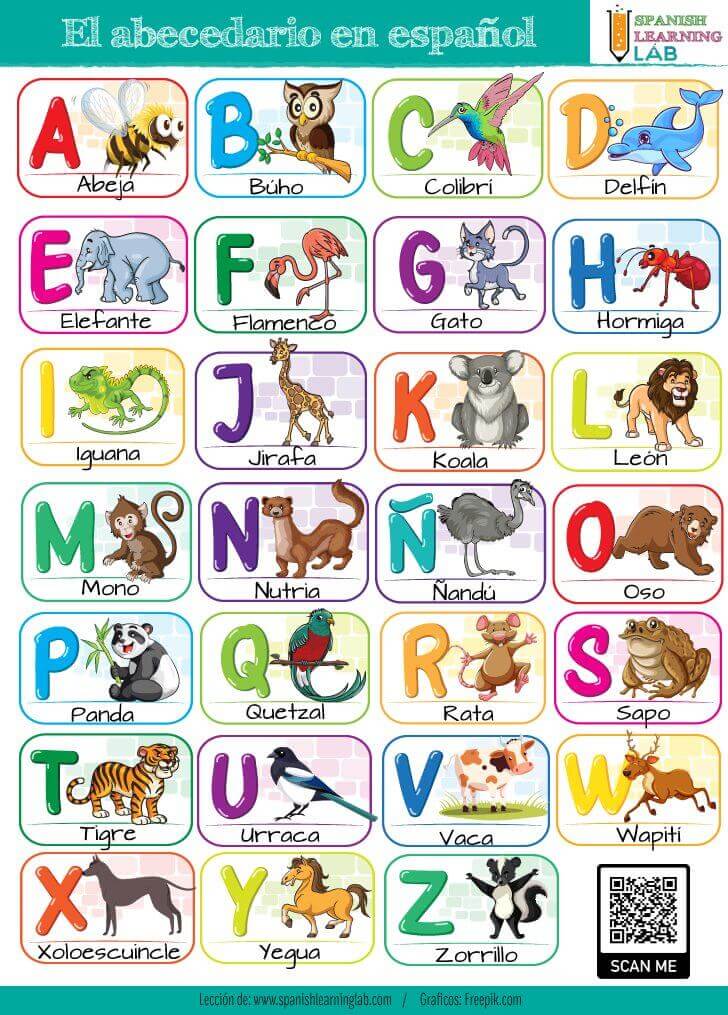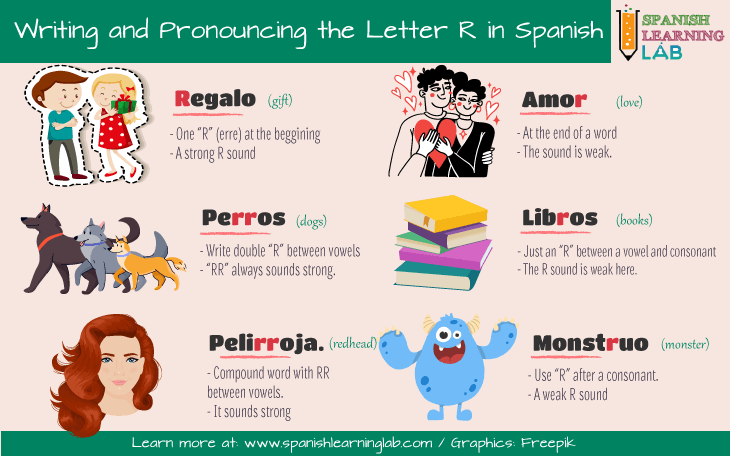The Spanish Alphabet is one of those topics you should master first when learning this language. It is quite simple to remember and really important to master it for spelling purposes. This short lesson will show you how to pronounce all the consonants and vowels that are part of the Spanish Alphabet. You will find examples of nouns with each letter. Let’s start…
A brief introduction to the Spanish Alphabet: Vowels and Consonants
The Spanish Alphabet, often called “Abecedario” or “Alfabeto”, is formed by twenty seven letters. Before 1994, the alphabet was composed by twenty nine letters, but the “Real Academia Española” (RAE) decided to exclude two of them: “CH” and “LL”. This way, only single letters are considered to be part of the alphabet and not these two special cases. Just like in English, the Spanish alphabet contains 5 vowels: “a, e, i, o, u”. Here is a picture showing all the letters in the “abecedario” plus a recording to listen to the pronunciation of the alphabet in Spanish.
Here is a great collection of pictures showing all the letters of the Spanish alphabet, along with a recording with their pronunciation. Many of these words are commonly used in different contexts, so it would be great if you get to learn their meaning.

How to pronounce the Spanish alphabet: sounds and examples
As you can see, all the letters in the picture can be found in the English alphabet, except for the letter “Ñ”. Remember there is also special letters like “CH” and “LL”. Next, we will show you the right pronunciation of each letter in the Spanish alphabet, followed by some examples of nouns with the vowels and consonants in the alphabet.
|
A, a – Avión, Águila
A, a – Airplane, Eagle
|
|
B, b – Barril, Bota
B, b – Barrel, Boot
|
|
C, c – Casa, Hamaca
C, c – House, Hammock
|
|
Ch, ch – Chile, Chocolate
Ch, ch – Chile, Chocolate
|
|
D, d – Dentista, Dedo
D, d – Dentist, Finger
|
|
E, e – Experto, Estudiante
E, e – Expert, Student
|
|
F, f – Fuego, Flor
F, f – Fire, Flower
|
|
G, g – Gato, Gallina
G, g – Cat, Hen
|
|
H, h – Hermano, Hielo
H, h – Brother, Ice
|
|
I, i – Isla, Iglesia
I, i – Island, Church
|
|
J, j – Joya, Jarrón
J, j – Jewel, Vase
|
|
K, k – Kimono, Kilo
K, k – Kimono, Kilogram
|
|
L, l – Lodo, Limón
L, l – Mud, lemon
|
|
LL, ll – Llama, Silla
LL, ll – Llama, Chair
|
|
M, m – Mamá, Mono
M, m – Mama, Monkey
|
|
N, n – Nuevo, Noticias
N, n – New, News
|
|
Ñ, ñ – Niño, Cariño
Ñ, ñ – Child, Affection
|
|
O, o – Ojo, Olor
O, o – Eye, Smell
|
|
P, p – Papá, Poder
P, p – Dad, Power
|
|
Q, q – Queque, Queso
Q, q – Cake, Cheese
|
|
R, r – Rosa, Ratón
R, r – Rose, Mouse
|
|
S, s – Sábado, Amigos
S, s – Saturday, Friends
|
|
T, t – Tigre, tomate
T, t – Tiger, tomato
|
|
U, u – Uno, Universidad
U, u – One, University
|
|
V, v – Vaso, Velo
V, v – Glass, Veil
|
|
W, w – Web, Kiwi
W, w – Web, Kiwi
|
|
X, x – Taxi, Boxeo
X, x – Taxi, Boxing
|
|
Y, y – Yeso, Yema
Y, y – Plaster, Yolk
|
|
Z, z – Zapato, taza
Z, z – Shoe, cup
|
Writing and Pronouncing Words with the Spanish Alphabet
The letter “R” in Spanish
A very interesting fact about the letter “R” in Spanish is that it has both a weak and strong pronunciation, for example: Marte (“soft R”) and “Rosa” (“strong R”). Generally, the letter “R” must be pronounced strongly when it comes at the beginning of a word, for example: “río, ropa, recio“. It is very important to understand that when the “R” is in the middle of two vowels, we must double the R and write “RR”, e.g.: “perro, barro, cerro“, and just the same way it will pronounce with a strong sound. “The double R” (doble erre) will only be used in that context, in the middle of vowels, otherwise a single “R” will be used.
Regardless of the rules, you have to be careful with the pronunciation of the letter R as some words may be confusing, e.g. words like “arena” (soft R) and “disruptivo” (strong R). Frequent practice of the language in real contexts is always helpful to ensure you are pronouncing words correctly. Pay close attention to the group of examples in the following image:

A Spanish tongue twister with the letter “R”
R con r cigarro,
r con r barril,
rápido ruedan los carros,
cargados de azúcar del ferrocarril.
The letters “C” and “Z”
The letter “C” is always pronounced the same as the letter “K” when it is placed at the beginning of words, both in Spain and Latin America, but this can vary when the “C” goes in the middle of words, as in “Promoción” (with the “S” sound) and “Cómico” (with the “K” sound). The letters “Z” and “C” are pronounced differently in Spain as compared to Latin America. In general, in countries like Mexico or Colombia, the “Z” and the “C” will sound practically the same as the letter “S”, and in fact, it is very difficult for many Latinos to pronounce these words with the same sound that Spaniards do.
Spanish Sayings with some letters of the alphabet
Pronunciation in Spain
Pronunciation in Latin America
- Zapatero a tus zapatos.
- Al ver al ladronzuelo en la oscuridad, encendí la luz en un abrir y cerrar de ojos.
- Yo siempre digo, en casa de herrero, cuchillo de palo.
Tongue twisters with the letters “C”, “V” and “P”
Pablito clavó un clavito en la calva de un calvito,
En la calva de un calvito, un clavito clavó Pablito.
Pancha plancha con cuatro planchas
¿Con cuántas planchas plancha Pancha?
The letters “v”, “z” and “h”
Sometimes the names of some of the consonants in the Spanish alphabet can vary from country to country, e.g. “V” (uve, ve chica, ve corta). Although the name of the letter itself can change, it is pronounced the same as “b” in all Spanish-speaking countries. The letter “Y” (ye, i griega) is pronounced the same as the double “L”, so words like “Llama” (flame) and “Yema” (yolk) have the same sound. Finally, it is very important to know that the letter “H” is silent, which means that even if the word has an “H” somewhere, you should not pronounce it at all, for example: “Hombre” (man) or “Albahaca” (basil).
There is much more to learn about the alphabet in Spanish, and we will certainly make use of this content in future lessons. We will focus on basic spelling rules in some lessons and provide examples of real situations where you might need this knowledge. Thanks for joining us! Enjoy learning Spanish!
Extra Practice: Spanish alphabet worksheet
Before you leave, we have created a worksheet for your to practice the alphabet in Spanish along with the vocabulary for farm animals and pets. Please follow the link and practice on your on.
